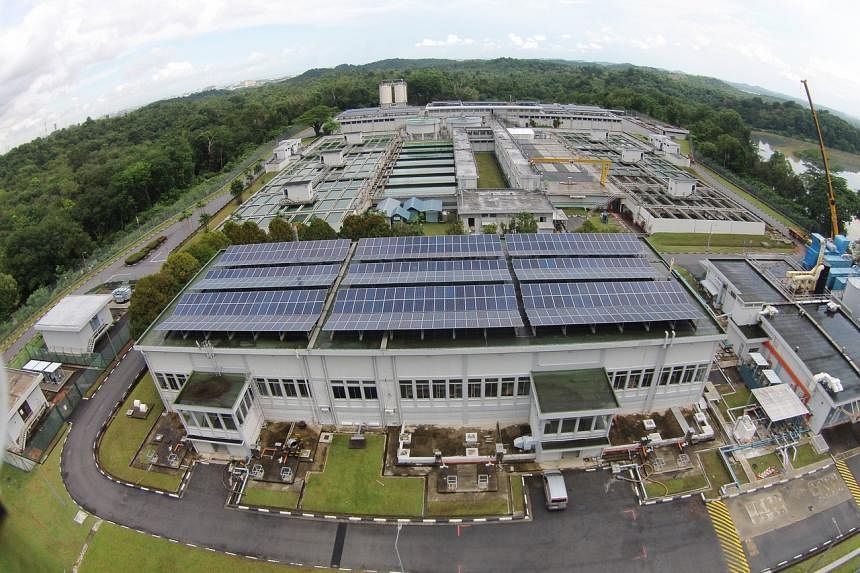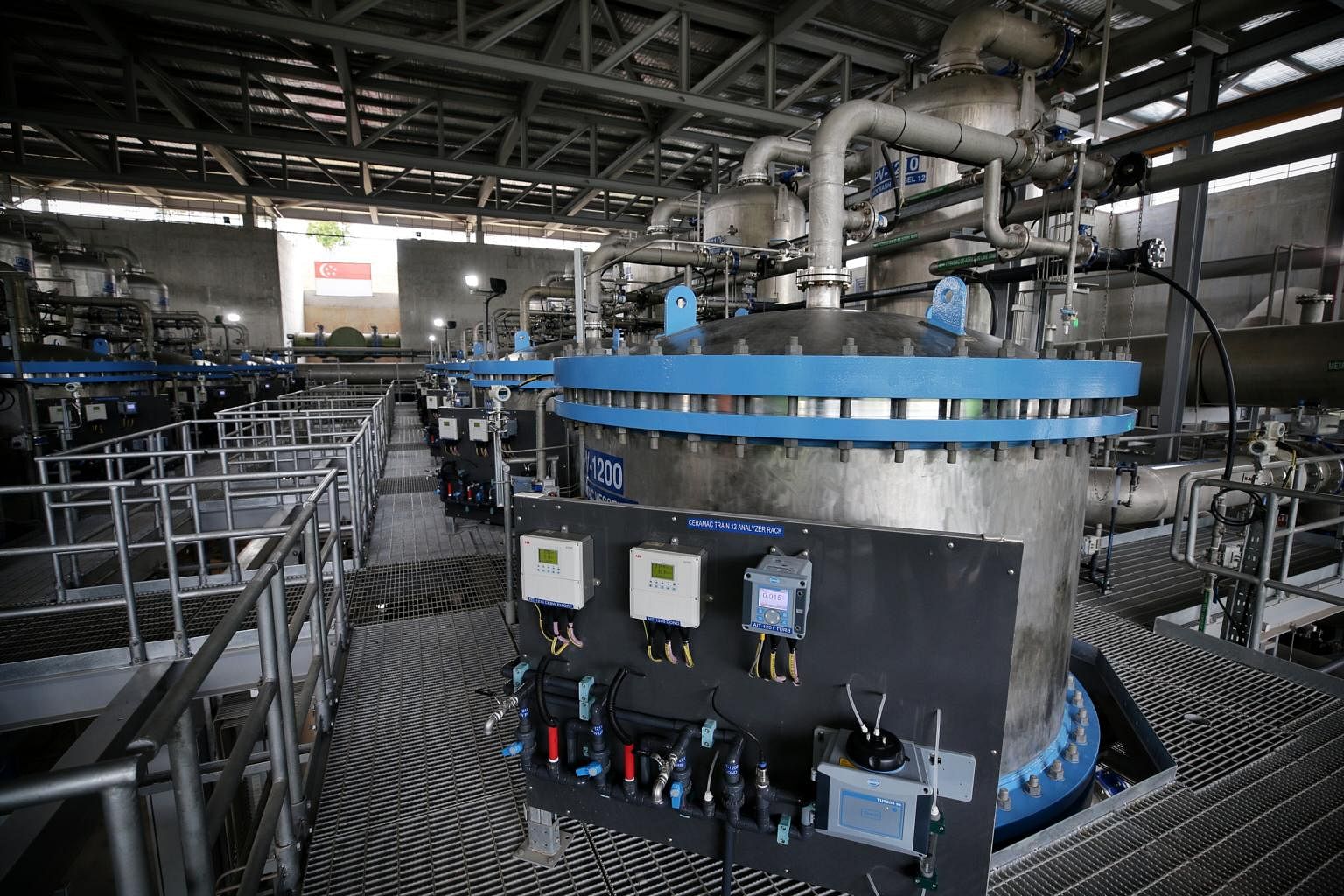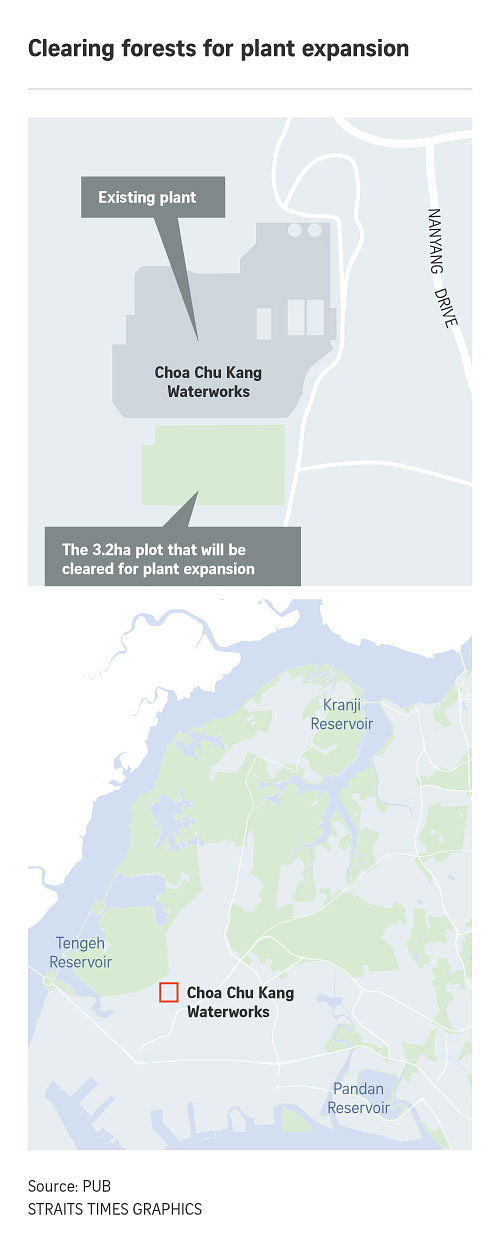Parts of Western Catchment forest to be cleared for expansion of water plant

SINGAPORE - Parts of the Western Catchment forest near the Nanyang Technological University will be cleared for the expansion of a water treatment plant, a move that will impact wildlife there.
The area has one of the largest and most biodiverse secondary forests in Singapore.
National water agency PUB said the upgrading of the aged Choa Chu Kang Waterworks, which is the only plant supplying treated reservoir water to the western part of Singapore, is vital for the nation's water security.
It added that it will take steps to reduce the impact on wildlife. Work to clear the forest is expected to start next year.
About 3.2ha of vegetation south of the existing site will be cleared for the expansion of the plant, which dates back to 1975. This is equivalent to the size of about six football fields.
An environmental impact assessment (EIA) for the project was completed at the end of last year.
Members of the nature community in Singapore were consulted by PUB in March this year, and the report was published on PUB's website on Monday evening (July 4).
The report, by sustainability consultancy firm Tembusu Asia Consulting, said the works are expected to negatively impact the flora and fauna in the Western Catchment forest.
The entire Western Catchment area, which houses a number of reservoirs and is also used by the military, is bound by Tuas in the south, the Johor Strait in the west, Lim Chu Kang to its north and Tengah to its east.
Wildlife in the area include the fern Helminthostachys zeylanica, which was found for the first time in Singapore during the biodiversity surveys done as part of the EIA.
The affected plot is also home to critically endangered Sunda pangolins and straw-headed bulbuls.
Two freshwater forest streams, considered rare habitats in Singapore, will also be affected by the works, said the report.
Surveys had shown that the streams are home to the critically endangered elf dragonfly. The Johnson's freshwater crab - a species found nowhere else in the world - has also been recorded in the streams there.

A Johnson's freshwater crab. Surveys showed that the crab, which cannot be found elsewhere in the world, were recorded in streams in the Western Catchment area. PHOTO: NPARKS
The report said that while "environmental impacts... are expected to be of slight to major negative levels", the negative impact can be cushioned if certain measures are undertaken.
EIAs evaluate the impact of a construction project on wildlife based on factors such as the permanence of the change and the importance of the species, meaning whether it is locally or globally endangered.
These scores are then pegged to a band and labelled using such terms as "moderate negative change" or "major positive change".
In this case, the report said the works will cause a "complete loss of certain habitats or ecological components", which could in turn affect sensitive creatures in the area.
"However, this can be reduced to moderate negative levels and lower by diligently implementing the environmental mitigation measures recommended in this report," added the report.
For example, to avoid directly impacting one of the streams in the area, PUB adjusted the boundaries of the project so there would be a 10m-wide strip of vegetation serving as a buffer between the main tributary of the stream and the project footprint.
Other proposed measures mentioned in the report include the installation of sound-proof barriers to reduce the impact of construction noise on sensitive wildlife; not conducting works at night and the establishment of tree protection zones so that some trees can be retained.
The report also recommended transplanting plants of high conservation value and relocating native aquatic fauna species.
Mr Chew Chee Keong, director of PUB's water supply (plants) department, said that while the measures will add to the overall time and cost of the project, the agency is committed to implementing all of them to mitigate the project's impact on the environment.
For example, saplings of plants that are of conservation significance will be salvaged and placed in a designated nursery or transplanted to other suitable habitats, he said.
"The salvaged species can be utilised in the replanting of the site if feasible, such as for reinstatement, slope stabilisation, forest enhancement or animal connectivity purposes," Mr Chew added.
Plans for the expansion of the Choa Chu Kang Waterworks were announced by PUB last year.
The agency said then that the plant would be upgraded with the latest water treatment technologies and smart capabilities to enhance its operations, maintenance, safety and security.
The expansion is expected to be completed in 2026.

Choa Chu Kang Waterworks is to be upgraded with the latest water treatment technologies and smart capabilities. PHOTO: ST FILE
Built in phases between 1975 and 1981, the plant draws water from the Kranji, Pandan and Tengah reservoirs to supply 80 million gallons per day - which can fill about 145 Olympic-sized swimming pools - of drinking water to the western part of the country.
Asked why PUB had to cut down parts of the Western Catchment forest instead of keeping the renovation work within the existing site, Mr Chew said the plant is the only one located in western Singapore.
"As part of PUB's long-term planning to safeguard water security, it is paramount that we conduct timely renewal of (the plant's) aged infrastructure to ensure it can continue to supply good and safe drinking water in the years to come," he added.
But there is not enough space within the existing plant to cater to both the operation of existing facilities, and the construction of new treatment facilities to replace old structures.
“Additional land is therefore needed to house the new infrastructure,” he said.
Mr Chew added that a key consideration when selecting the plot of land was the potential for lower energy consumption in the longer term, which would reduce the overall carbon footprint of the plant.
The parcel of land to be cleared is at a comparatively lower ground level compared with the original site of the plant, which eliminates the need to construct pumping facilities, said PUB.
This will help to improve energy efficiency and reduce the carbon footprint of the plant during its operations, the EIA report noted.
"PUB sought to limit the land take and made a decision to leave as much of the natural streams out of the plant's footprint as it was possible," Mr Chew said.

Dr Vilma D'Rozario, co-director of local wildlife group Singapore Wildcat Action Group, said PUB had consulted the nature community on the project.
"Our concerns were for the natural streams and notable, native flora and fauna, but it looks like carefully planned mitigation measures have been set out," she said.
Dr D'Rozario said she was heartened by the thorough survey of flora and fauna, and by PUB's commitment to carry out the mitigation measures.
But she added that it was equally important that the measures are implemented as well as they were planned.
"It's so difficult to balance our needs for clean water in the west with preservation of native biodiversity," she said.
"Yet, the reconstruction of the water plant is just one of a few other large developments in the area, including a station for the nearby Jurong Region Line.
"So, coming all together, this will be a blow to biodiversity."
The environmental impact assessment report for the Choa Chu Kang Waterworks can be found on PUB's website.
Members of the public can provide their feedback on the report by Aug 1, 2022.

No comments
Share your thoughts! Tell us your name and class for a gift (: